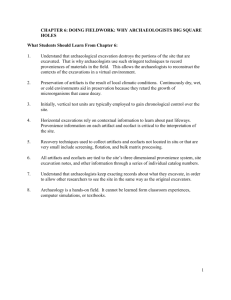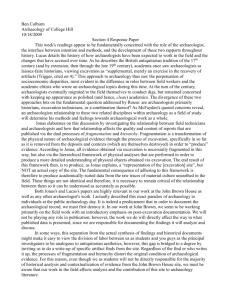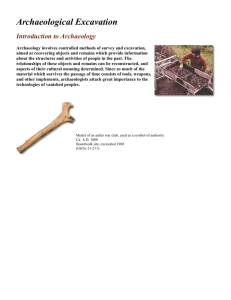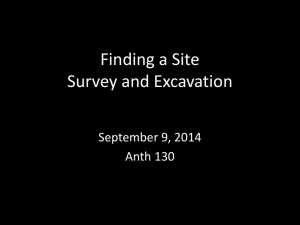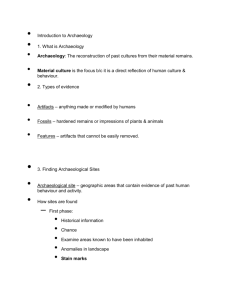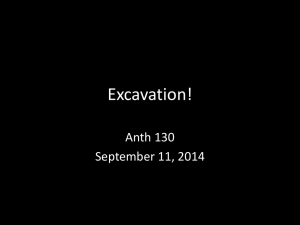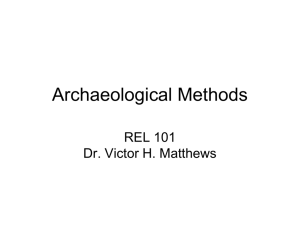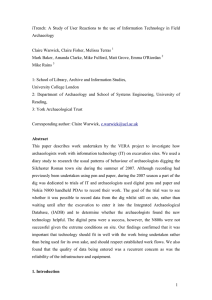How Does Archaeology Get Done?
advertisement
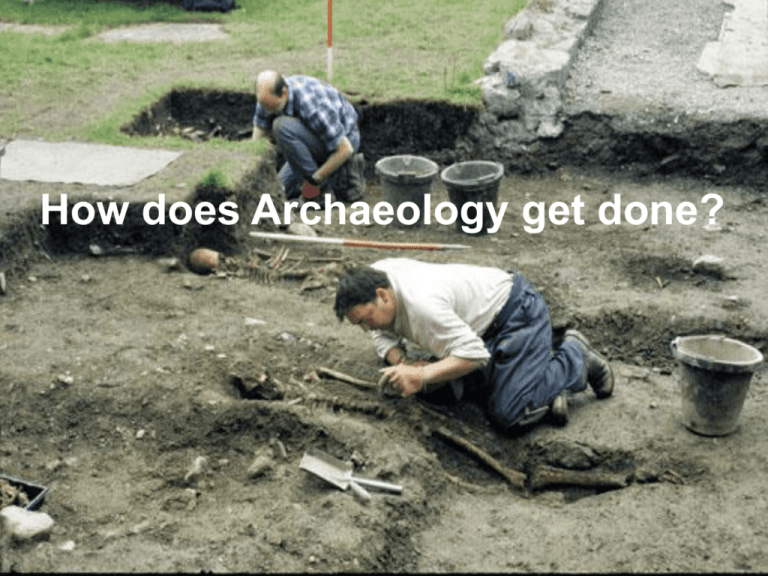
How does Archaeology get done? What archaeology isn’t Archaeologists don’t do dinosaurs! That’s paleontology. It’s not just about digging! It’s complicated, meticulous work that demands training, patience and big budgets. It’s extremely interdisciplinary. In other words, it’s not what most people think it is. Some Types of Archaeology Paleoanthropology Classical Some Types of Archaeology Anthropological Historical Some Types of Archaeology Underwater Industrial The Goals of Archaeology 1. Discovering the past Excavation & Description 2. Reconstructing culture history Who was where, when, with what? 3. Explaining cultural processes How and why do cultures change or stay the same? 4. Interpreting Past Cultures What did peoples’ lives mean? Sites What are they? Places where past human activity occurred Some common site types: Habitation―places where people lived Procurement―places where people got resources Processing―places where people converted resources to products Sacred―places where people practiced activities related to their ideology Specialized―places with unique purposes Sites are defined by what’s in them. Habitation Sites Procurement Sites Processing Sacred Specialized What do archaeologists find? Artifacts—transportable objects made and used by past peoples Features—formed or built by people, these “objects” can’t be moved Activity areas—clusters of artifacts and features resulting from particular activities Ecofacts—environmental elements that exhibit traces of human use or activity Ideofacts—objects or features that contain information about peoples’ belief systems Sociofacts—objects or features that contain information about peoples’ social structure Items can fit in more than one category. Information, not the item, is the key. How Sites Are Formed Taphonomy—The study of how paleontological and archaeological remains ended up in a particular place. Primary refuse—When the items used together and deposited together are left exactly where they fell by ancient people. Secondary refuse—Deposits where people took their trash to a pile or pit, removing it from the immediate vicinity of their living quarters. How Sites Are Found Scientists ask around or read reports. Sophisticated remote-sensing devices—groundpenetrating radar, proton magnetometers, or electrical resistivity meters, can help search for sites. Pedestrian Survey Scientists search for sites through a process of subsurface sampling, placing test pits at regular intervals. How Information Is Recovered Literature searches, maps, site forms Surface Survey/subsurface testing Sampling Test excavations Excavations Analysis Context is crucial! A single artifact, devoid of any context, provides only a fraction of the information provided by an object for which context has been preserved and recorded. All data recovery is slow and tedious, so as not to lose context. A typical archaeological excavation looks like this: square holes on a grid system, measuring tapes, shovels (sometimes), and lots of sitting around taking notes or photos. The most important tools in archaeology are a small (5 ½ inch) bricklayer’s trowel, a tape measure, and a notebook. Everything after that is gravy. None of this happens without a research design! Formulation involves defining the research problem, performing background investigations, and conducting feasibiliity studies. Implementation involves completing all the necessary arrangements for planning the work One of the most difficult parts including everything from finance to permissions. Who pays for archaeological research? Data Acquisition: reconnaissance, survey, and excavation (steps are not mutually exclusive!) Reconnaissance is locating sites without excavation Survey records as much as possible about sites without excavation Excavation exposes the buried cultural remains and other characteristics of sites, recording or retrieving data Data Processing is the manipulation of materials (raw data) including the treatment of artifacts, measurements, development of records such as maps. Analysis provides information about each type of data, such as artifacts, ecofacts, ideofacts, features. Some can be done in the field, but much more is done in the lab. Estimates of lab:field in terms of time range from 510 times more in the lab. Analyzing Archaeological Data Artifacts The Sources of Raw Materials Determined through trace element analysis in which impurities in tiny or “trace” amounts are scanned for. Uses procedures such as neutron activation analysis and x-ray fluorescence. Tool Manufacture and Use Experimental replication is the process of attempting to authentically re-create ancient artifacts. Morphology is the form of the object, what it looked like, and by the evidence of wear patterns. Social Patterns, based on distribution (a sociofact) Understanding Past Behavior Archaeologists use ethnoarchaeology (the study of living populations as analogy). Archaeologists also experiment in order to reconstruct. Publication and Public Archaeology It does little good to dig and analyze unless you publish your findings. In fact, it’s unethical! Public accountability They usually pay the bills, and it’s often their heritage


